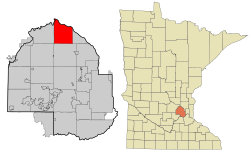2020 census
As of the 2020 census, there were 7,262 people, 2,458 households, 2,035 families residing in the city. [10] The population density was 310.1 inhabitants per square mile (119.7/km2). There were 2,605 housing units. The racial makeup of the city was 80.7% White, 3.3% African American, 0.5% Native American, 3.0% Asian, 0.0% Pacific Islander, 5.9% from some other races and 6.6% from two or more races. Hispanic or Latino of any race were 9.7% of the population. [11]
2010 census
As of the 2010 census, there were 4,671 people, 1,638 households, and 1,319 families living in the city. The population density was 200.9 inhabitants per square mile (77.6/km2). There were 1,699 housing units at an average density of 73.1 per square mile (28.2/km2). The racial makeup of the city was 93.7% White, 0.5% African American, 0.2% Native American, 2.0% Asian, 0.1% Pacific Islander, 1.8% from other races, and 1.7% from two or more races. Hispanic or Latino of any race were 8.8% of the population.
There were 1,638 households, of which 35.5% had children under the age of 18 living with them, 66.8% were married couples living together, 7.4% had a female householder with no husband present, 6.3% had a male householder with no wife present, and 19.5% were non-families. 14.3% of all households were made up of individuals, and 4.2% had someone living alone who was 65 years of age or older. The average household size was 2.85 and the average family size was 3.12.
The median age in the city was 41.7 years. 24.6% of residents were under the age of 18; 8.2% were between the ages of 18 and 24; 22.5% were from 25 to 44; 35.7% were from 45 to 64; and 9% were 65 years of age or older. The gender makeup of the city was 52.2% male and 47.8% female.
2000 census
As of the 2000 census, there were 4,699 people, 1,550 households, and 1,292 families living in the city. The population density was 200.4 inhabitants per square mile (77.4/km2). There were 1,566 housing units at an average density of 66.8 inhabitants per square mile (25.8/km2). The racial makeup of the city was 95.28% White, 0.64% African American, 0.64% Native American, 0.81% Asian, 1.87% from other races, and 0.77% from two or more races. Hispanic or Latino of any race were 2.75% of the population. 31.6% were of German, 13.5% Swedish, 11.0% Norwegian and 7.9% Irish ancestry.
There were 1,550 households, out of which 45.7% had children under the age of 18 living with them, 71.9% were married couples living together, 7.9% had a female householder with no husband present, and 16.6% were non-families. 11.7% of all households were made up of individuals, and 2.1% had someone living alone who was 65 years of age or older. The average household size was 3.03 and the average family size was 3.29.
In the city, the population was spread out, with 30.5% under the age of 18, 7.8% from 18 to 24, 33.2% from 25 to 44, 23.7% from 45 to 64, and 4.7% who were 65 years of age or older. The median age was 35 years. For every 100 females, there were 103.1 males. For every 100 females age 18 and over, there were 105.1 males.
The median income for a household in the city was $66,875, and the median income for a family was $71,356. Males had a median income of $41,476 versus $30,386 for females. The per capita income for the city was $27,756. About 1.0% of families and 2.7% of the population were below the poverty line, including 3.7% of those under age 18 and none of those age 65 or over.



